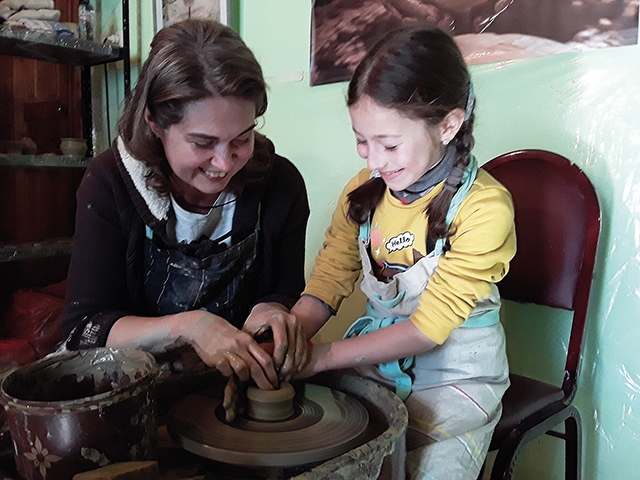Sleeves Up: Etseri, Svaneti
BLOG
It’s been about a year since my friends brought a pottery wheel, quite a few kilos of raw earthenware, and other associated tools and supplies to our house and gave the local children a couple of weeks of intensive after-school classes in ceramic arts.
They’re back now, with two wheels, 100 kg, and a whole lot more experience and expectation. Once again they have transformed one of our dining rooms into a plastic-covered safe area for exploring and getting one’s hands “dirty” with clay. This time, music plays in the background and a slideshow offers inspiration for young eyes and hands.
The children have been waiting for this return for weeks, since we told them, and are now several days into it. New ones are trying their hand at the wheel for the first time ever. (Most important lesson, at the wheel as in life: if it’s centered, the possibilities are limitless; off-center, and sooner or later it’ll betray you and fail). Occasional power outages don’t faze us: the generator takes over and the wheels turn. The big Svan stove provides heat as necessary, along with some blessed days of sunlight melting the accumulated snow outside and warming our hearts.
Those who fell in love with ceramics last time are back for more. Others who never gave themselves a turn at the wheel are feeling the sheer, actual magic of that lump responding to their hands, arms, fingers, growing up, shrinking down again, opening out into a vessel. They’re hand-building too, with all sorts of instruments to roll out, add texture, pierce, carve.
Once everything is “bone dry”, when no more water can come out of it at room temperature, it can still be dissolved back into workable clay simply by putting back that water. Fire it to a high enough initial temperature, though, and you permanently change its chemical composition, driving out all remaining H2O: bisque or biscuit firing. Then, after glazing it if desired, you can fire it again, hotter, to about 1000-1150 degrees C for earthenware, over 1200 degrees for stoneware and porcelain. At these temperatures some of the material in it actually vitrifies, or begins a bit of melting; once cooled and hardens, the piece is now much stronger, as strong as it can get, matured.
Last year I discovered, because it was too easy not to try, that my Svan wood-burning stove will get hot enough for an earthenware bisque firing… and commenced using it to do just that, with everything we made. This time we plan to do the same. I’ve been storing cut and split wood in a crawl space right under where the clay room is, accessed by a trapdoor. No more dressing to go outdoors and dig down to find a snow-covered tarpaulin under which is my firewood! It’s there waiting for me.
We’re not glazing yet, partly because the glazes are virtually impossible to come by in Georgia, and partly because I have no oven hot enough to do the second firing. But we’re already thinking about future clay camps, including an outdoor raku firing, which involves taking nearly red-hot pieces out of the kiln with tongs, plunging it into a container of combustible material like hay, letting that catch fire, then putting a lid on it. The fire, trying to continue burning, takes oxygen from the piece’s glaze and deposits salts onto it, along with some very handsome cracks. Thrilling stuff, if we can do it.
The looks on young people’s faces as clay responds to their touch are all the reward they, and we, need.
Tony Hanmer has lived in Georgia since 1999, in Svaneti since 2007, and been a weekly writer and photographer for GT since early 2011. He runs the “Svaneti Renaissance” Facebook group, now with nearly 2000 members, at www.facebook.com/groups/SvanetiRenaissance/
He and his wife also run their own guest house in Etseri: www.facebook.com/hanmer.house.svaneti
By Tony Hanmer












